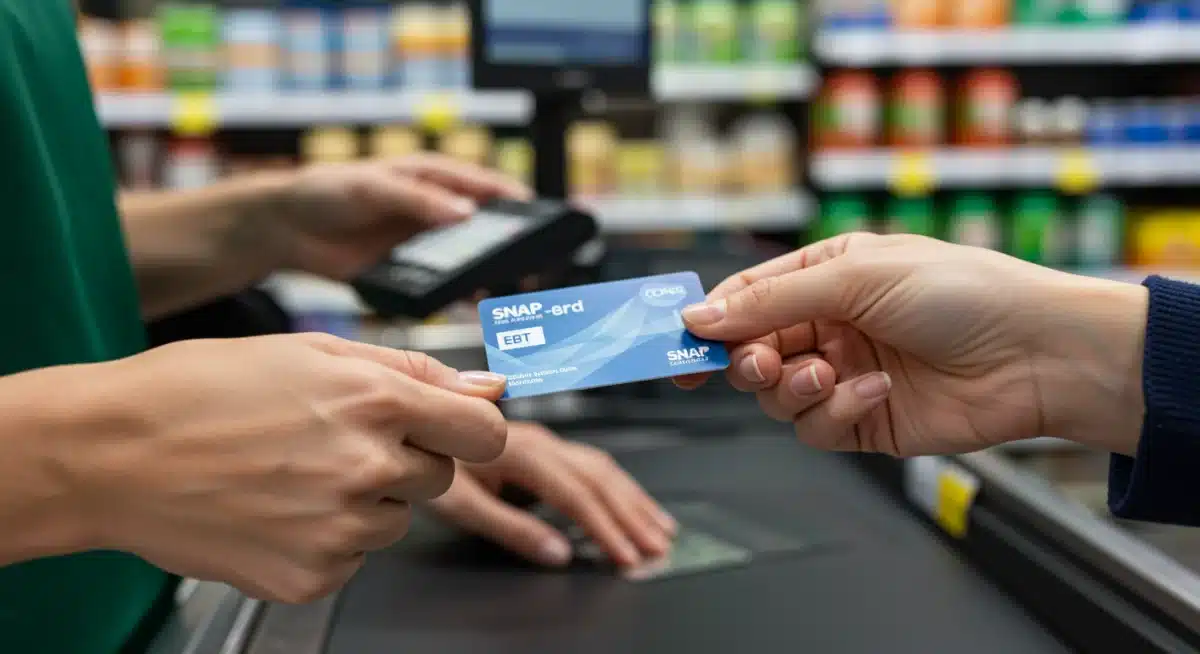Maximize SNAP Benefits 2025: 5 Strategies for More Food Assistance

To maximize your SNAP benefits in 2025, focus on reporting all eligible expenses, understanding deductions, utilizing specific state programs, and proactively updating household information to potentially increase monthly food assistance by up to 15%.
Are you looking to make the most of your food assistance in the coming year? Learning how to maximize SNAP benefits in 2025 can significantly impact your household’s food budget. Many eligible families often leave money on the table simply because they are unaware of all the available deductions and strategies. This guide will explore five lesser-known approaches to help you potentially increase your monthly food assistance by up to 15%, ensuring your family has access to the nutritious food it needs.
Understanding the Basics of SNAP Eligibility and Calculation
Before diving into advanced strategies, it’s crucial to have a solid grasp of how SNAP (Supplemental Nutrition Assistance Program) eligibility and benefit amounts are determined. The program is designed to help low-income individuals and families purchase healthy food. Eligibility is primarily based on household size, income, and certain expenses. While these basics are widely known, the nuances of income calculations and allowable deductions often hold the key to unlocking higher benefits.
The federal government sets general guidelines, but each state administers its own SNAP program, leading to variations in application processes and some specific deductions. Understanding your state’s particular rules is a fundamental step toward maximizing your benefits. Your gross income (before deductions) and net income (after deductions) are both considered, with specific limits that vary by household size. Assets are also typically reviewed, though many states have simplified asset tests.
Key Income and Deduction Factors
Income limits for SNAP are updated annually and are tied to the federal poverty level. For most households, gross income must be at or below 130% of the federal poverty level, and net income must be at or below 100%. However, certain households, such as those with elderly or disabled members, may have different income thresholds. The deductions allowed are critical because they reduce your countable income, which in turn can increase your benefit amount.
- Standard Deduction: A fixed amount subtracted from your gross income, varying by household size.
- Earned Income Deduction: A percentage (usually 20%) of any earned income is disregarded.
- Dependent Care Deduction: Costs for child care or care for other dependents necessary for work or training.
- Medical Expense Deduction: For elderly or disabled household members, out-of-pocket medical costs exceeding a certain amount.
It’s important to keep meticulous records of all potential deductions. Many people overlook smaller, seemingly insignificant expenses that can collectively make a difference. For instance, even minimal co-pays for doctor visits or transportation costs to medical appointments can add up. Being proactive in tracking and reporting these can directly impact your monthly allocation.
In essence, mastering the foundational elements of SNAP—eligibility criteria, income limits, and the types of deductions allowed—provides the bedrock for applying more advanced strategies. A thorough review of your household’s financial situation against these criteria is the first step in identifying opportunities to increase your benefits in 2025.
Strategy 1: Meticulously Document All Allowable Deductions
One of the most overlooked aspects of maximizing SNAP benefits is the diligent documentation of every allowable deduction. While standard deductions are automatically applied, many households fail to report specific expenses that can significantly lower their countable income, thereby increasing their monthly food assistance. This strategy can be particularly impactful, potentially boosting your benefits by several percentage points.
Many individuals are aware of major deductions like child care, but lesser-known expenditures often go unreported. For instance, medical expenses for elderly or disabled household members can be a substantial deduction. This includes not just doctor’s visits and prescriptions, but also over-the-counter medications, medical supplies, transportation to appointments, and even specific dietary needs prescribed by a physician. The key is to track every dollar spent on these items throughout the year.
Unearthing Hidden Medical Expenses
For qualifying household members, medical expenses exceeding a certain threshold (often $35 per month) can be deducted. This threshold is cumulative, meaning several small expenses can add up to a significant deduction. Don’t just think big; consider all related costs.
- Prescription costs: All co-pays and out-of-pocket expenses for prescribed medications.
- Over-the-counter necessities: Items like bandages, pain relievers, and supplements if recommended by a doctor.
- Transportation for medical care: Mileage, bus fares, or taxi costs to and from appointments.
- Health insurance premiums: Premiums not paid by a third party.
Another often-missed deduction is shelter costs. While rent or mortgage payments are obvious, utilities can also be a significant factor. Most states offer a standard utility allowance (SUA), but if your actual utility costs (electricity, gas, water, trash, phone) are higher than the SUA, you may be able to deduct the actual amount. This requires careful record-keeping of all utility bills.
It’s essential to gather and organize receipts, statements, and any other documentation related to these expenses. When you apply for or recertify your SNAP benefits, providing comprehensive documentation can make a substantial difference. Don’t assume an expense is too small to matter; every little bit contributes to reducing your net income and potentially increasing your SNAP allocation. Proactive record-keeping throughout the year simplifies the application process and ensures you don’t miss out on eligible deductions.
Strategy 2: Proactively Update Household Information and Changes
Life circumstances are constantly evolving, and these changes can directly impact your SNAP benefit levels. Many households fail to report changes in a timely manner, which can either lead to under-receiving benefits or, conversely, receiving overpayments that must later be repaid. Proactively updating your household information is a critical, yet often neglected, strategy to optimize your SNAP allocation in 2025.
Any change in income, household size, or expenses should be reported to your state SNAP agency as soon as possible. Even seemingly minor adjustments can shift your eligibility or benefit amount. For example, if a household member loses a job, their income reduction could qualify the household for increased benefits. Conversely, an increase in income might reduce benefits, but reporting it promptly prevents future penalties.
Impact of Household Composition Changes
The number of people in your household significantly influences your SNAP benefits. Adding a new child, an elderly parent, or another dependent can increase your household size, thereby raising the income thresholds and potentially increasing your benefits.
- New births or adoptions: Promptly report any new additions to your family.
- Elderly or disabled individuals joining the household: These members often qualify for additional deductions, such as medical expenses.
- Dependents moving in or out: Any change in who resides in your household should be communicated.
Beyond changes in household composition, shifts in housing costs or utility expenses are also vital to report. If your rent increases, or if you move to a location with higher utility bills, these changes could lead to a higher shelter deduction. Conversely, if your housing costs decrease, reporting this prevents overpayment issues. The key is to understand that SNAP calculations are dynamic and reflect your current financial reality.
Establishing a system for tracking these changes throughout the year is highly recommended. Keep a dedicated folder for any documents related to income, household members, or expenses. When it’s time for your annual recertification, or if a significant change occurs mid-year, you’ll have all the necessary information readily available, ensuring your benefits accurately reflect your household’s needs.
Strategy 3: Leverage State-Specific Programs and Waivers
While SNAP is a federal program, its implementation varies significantly from state to state. Many states offer unique programs, waivers, or expanded eligibility criteria that can further benefit eligible households. Failing to research and leverage these state-specific opportunities means potentially missing out on additional assistance. This strategy emphasizes understanding your local SNAP landscape to maximize your benefits in 2025.
Some states have received federal waivers allowing them to adjust certain SNAP rules. For instance, some states might have higher asset limits or simplified reporting requirements for specific populations. Others might offer additional food assistance programs that complement federal SNAP benefits, often through partnerships with local food banks or community organizations. These programs are designed to address unique state-level needs and can provide a valuable boost to your food budget.
Exploring State-Specific Deductions and Allowances
Beyond the standard federal deductions, certain states may offer additional allowances or higher caps for specific expenses. For example, some states might have more generous utility allowances or specific deductions for educational expenses related to job training.
- Expanded Medical Expense Deductions: Some states may have lower thresholds for medical expense deductions or include a broader range of eligible costs.
- Higher Standard Utility Allowances (SUAs): States in colder climates, for instance, might have higher SUAs to account for increased heating costs.
- Specific Resource Exclusions: Certain states may exclude more types of assets when determining eligibility, such as specific retirement accounts or vehicles.
To uncover these opportunities, it’s essential to consult your state’s Department of Social Services or equivalent agency. Their websites typically provide detailed information on SNAP policies, including any state-specific programs or waivers. Additionally, local community centers, food banks, and non-profit organizations often have staff knowledgeable about these nuanced state programs and can offer personalized guidance. Don’t rely solely on federal guidelines; investigate what your state specifically offers to ensure you are receiving all the assistance you qualify for.

Strategy 4: Understand and Utilize the EBT Card Effectively
While the Electronic Benefits Transfer (EBT) card is the primary method for accessing SNAP benefits, many recipients don’t fully understand its functionalities or how to use it most effectively. Beyond simply swiping at the grocery store, there are ways to maximize the value of your EBT card and ensure your benefits stretch further. This involves understanding what can and cannot be purchased, as well as exploring additional programs linked to EBT.
The EBT card works much like a debit card, allowing you to purchase eligible food items. However, knowing the specific rules about what can be bought is crucial. SNAP benefits are intended for food for the household to eat, excluding prepared hot foods, alcohol, tobacco, and non-food items like pet food, soap, or household supplies. Being clear on these distinctions helps prevent accidental purchases that could lead to issues or wasted time at checkout.
Beyond Basic Food Purchases
Several programs offer additional benefits or discounts to EBT cardholders, enhancing the value of your SNAP benefits. These are often state or local initiatives and can include discounts on admission to museums, zoos, or other cultural institutions, as well as participation in farmers’ market incentive programs.
- Farmers’ Market Match Programs: Many farmers’ markets offer programs (e.g., “Double Up Food Bucks”) where your SNAP dollars are matched, effectively doubling your purchasing power for fresh produce.
- Museums for All: A nationwide program offering free or reduced admission to museums and cultural institutions for EBT cardholders.
- Online Grocery Shopping: In an increasing number of states, SNAP benefits can be used for online grocery purchases, offering convenience and potentially access to better deals.
Another aspect of effective EBT utilization is budgeting. Since benefits are typically loaded once a month, planning your purchases can prevent running out of funds before the next cycle. Creating a meal plan and a shopping list based on your EBT balance can help you make strategic purchases, focusing on nutritious and cost-effective items. Some states also offer nutrition education programs to SNAP recipients, providing valuable tips on healthy eating on a budget, which can further extend the impact of your benefits. Utilizing your EBT card smartly means getting the most food for your family’s needs and exploring all associated advantages.
Strategy 5: Seek Professional Guidance and Advocacy
Navigating the complexities of SNAP eligibility and maximizing benefits can be challenging, especially with varying state rules and annual updates. One of the most effective, yet often underutilized, strategies is to seek professional guidance and advocacy. Connecting with experts and organizations specializing in food assistance can provide invaluable support, clarification, and direct assistance in ensuring you receive all eligible benefits.
Many non-profit organizations, community legal aid services, and local government agencies offer free assistance to individuals and families applying for or managing SNAP benefits. These professionals are well-versed in the latest regulations, understand common pitfalls, and can help you identify deductions or programs you might have missed. They can also assist with the application process, help gather necessary documentation, and even represent you in appeals if your benefits are denied or reduced unfairly.
Where to Find Expert Assistance
Knowing where to turn for help is crucial. Several types of organizations are dedicated to assisting low-income households with food insecurity challenges.
- Local Food Banks: Beyond providing food, many food banks offer outreach programs to help people apply for SNAP and understand their benefits.
- Community Action Agencies: These organizations provide a wide range of services to low-income individuals, including assistance with public benefits.
- Legal Aid Societies: If you face a denial or reduction of benefits, legal aid can offer pro bono or low-cost representation.
- State SNAP Hotlines/Websites: Your state’s SNAP agency often has dedicated helplines and comprehensive websites with FAQs and local office information.
Engaging with an advocate can be particularly beneficial if your household has unique circumstances, such as a self-employed member, a student, or complex medical expenses. These situations often require a deeper understanding of SNAP rules to properly report income and deductions. An advocate can help ensure all your eligible circumstances are accurately reflected in your application, potentially leading to a higher benefit amount. Don’t hesitate to reach out for help; these resources exist to support you in maximizing your food assistance.
Future-Proofing Your SNAP Benefits for 2025 and Beyond
As we look towards 2025, maximizing your SNAP benefits isn’t just about current strategies; it’s also about preparing for future changes and ensuring long-term stability. The landscape of public assistance programs can shift due to economic factors, legislative updates, and evolving state policies. Adopting a proactive and informed approach will help you adapt to these changes and maintain optimal benefit levels.
One key aspect of future-proofing is staying informed about policy changes. Federal and state governments regularly update SNAP regulations, income thresholds, and deduction limits. Subscribing to newsletters from your state’s SNAP agency or reputable advocacy groups can keep you abreast of these developments. Understanding upcoming changes empowers you to adjust your reporting or spending habits accordingly, preventing any unexpected reduction in benefits.
Anticipating Policy Shifts and Economic Impacts
Economic indicators, such as inflation and unemployment rates, often influence the value and availability of SNAP benefits. For instance, in times of high inflation, the cost of food rises, which can sometimes lead to adjustments in maximum benefit amounts or eligibility criteria.
- Annual Cost-of-Living Adjustments (COLAs): Be aware that benefit amounts and income limits are typically adjusted annually to account for inflation.
- Emergency Allotments: While often temporary, periods of economic hardship may trigger emergency allotments, providing additional benefits.
- Legislative Changes: New federal or state laws can impact SNAP. Staying informed about legislative proposals related to food assistance is crucial.
Another crucial element is continuous education about nutrition and budgeting. Even with increased benefits, making informed choices at the grocery store can significantly extend your food dollars. Many SNAP-eligible households can access free nutrition workshops or resources that teach meal planning, smart shopping techniques, and how to prepare healthy meals on a budget. These skills are invaluable, regardless of your benefit amount.
Finally, building a strong support network is essential. This includes maintaining communication with your SNAP caseworker, connecting with community resources, and staying in touch with advocacy groups. These connections can provide not only practical assistance but also a sense of community and shared knowledge, helping you navigate the system effectively for years to come. By adopting these forward-thinking practices, you can ensure your household’s food security remains robust.
| Key Strategy | Brief Description |
|---|---|
| Document Deductions | Meticulously track and report all eligible expenses, including lesser-known medical and shelter costs, to lower countable income. |
| Update Information | Promptly report changes in income, household size, and expenses to ensure accurate benefit calculation. |
| Leverage State Programs | Research and utilize state-specific waivers, additional programs, and expanded eligibility criteria for extra assistance. |
| Seek Professional Guidance | Connect with non-profits and agencies for expert advice, application assistance, and advocacy to optimize benefits. |
Frequently Asked Questions About Maximizing SNAP Benefits
Your SNAP benefit amount is primarily determined by your household size, gross income, and eligible deductions. The more deductions you qualify for and report, the lower your net income becomes, which can lead to higher monthly benefits. Each state also has specific income thresholds tied to the federal poverty level.
You should report significant changes in income, household composition, or expenses as soon as as possible, ideally within 10 days of the change. Prompt reporting ensures your benefits are accurately calculated and helps avoid potential overpayments or underpayments, maintaining compliance with program rules.
Yes, in an increasing number of states, SNAP benefits can be used for online grocery purchases. Major retailers like Amazon, Walmart, and others participate in the SNAP Online Purchasing Program. Check your state’s SNAP website or the USDA’s FNS website for a list of participating retailers and specific guidelines in your area.
Many farmers’ markets offer incentive programs, such as “Double Up Food Bucks,” which match your SNAP dollars when you purchase fresh produce. These programs effectively double your purchasing power for fruits and vegetables, promoting healthy eating and supporting local farmers. Inquire at your local farmers’ market for participation details.
Various organizations offer assistance, including local food banks, community action agencies, and legal aid societies. These groups can help with application processes, identify eligible deductions, provide appeals support, and inform you about state-specific programs. Seeking their expertise can significantly optimize your benefit allocation.
Conclusion
Maximizing your SNAP benefits in 2025 goes beyond simply applying for assistance; it requires a strategic, informed, and proactive approach. By meticulously documenting all allowable deductions, staying vigilant about reporting household changes, leveraging unique state-specific programs, and effectively utilizing your EBT card, you can significantly increase your monthly food assistance. Furthermore, recognizing the value of professional guidance and advocacy ensures you navigate the complexities of the system with confidence. These lesser-known strategies empower you to secure the maximum possible support for your household’s nutritional needs, contributing to greater food security and overall well-being. Staying informed and engaged with available resources will be key to sustaining these benefits long-term.





